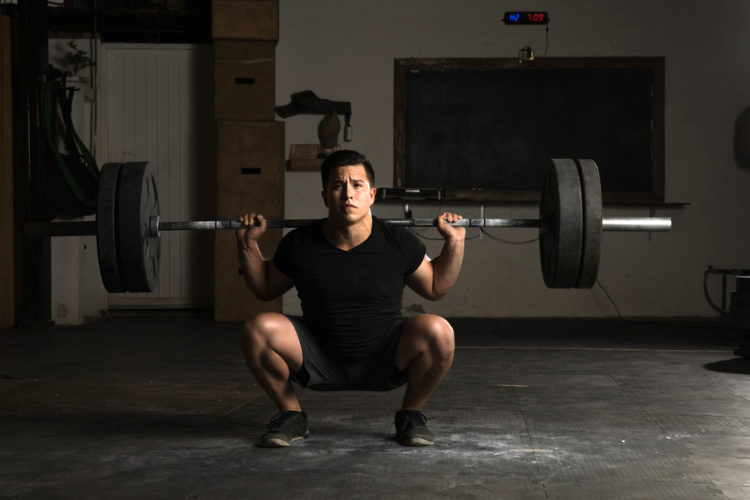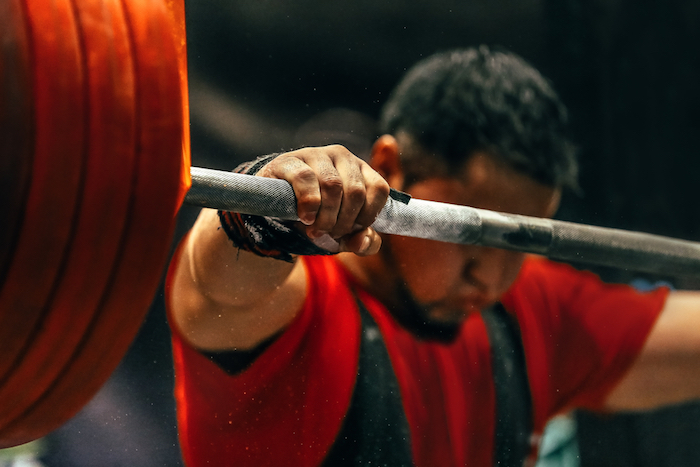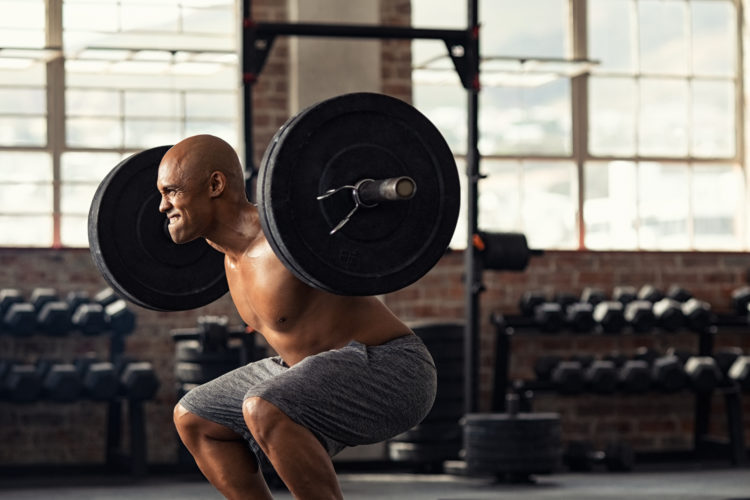“The sphere of physical endeavor might very aptly be grouped into two classifications: those who just naturally seem to excel and those who must depend upon hard work and long training to achieve anything worthwhile…”
Mark Berry, 1933.(1)
“Trust me, if you do an honest 20-rep program, at some point Jesus will talk to you. On the last day of the program, he asked if he could work in…”
Mark Rippetoe, 2008.(2)
Writing in different decades but on the same topic, Mark Berry and Mark Rippetoe’s appreciation for the twenty-rep squat program speaks to the workout’s longevity, popularity and, crucially, its effectiveness.
For those unfamiliar with the program, the premise is simple: take a weight you would normally squat for ten reps and, through force of will, deep breathing and tactical pauses, squat for twenty reps. Done once or twice a week for several weeks and, combined with copious amounts of food, the program is almost guaranteed to increase one’s strength and bodyweight.
Admittedly, this is not a particularly fun way to train. Rippetoe’s assertion of divine intervention in the weight room may seem over the top, but it’s not far off. Even from its inception in the 1930s, fitness coaches spoke of its harshness and difficulty. Despite these obstacles, the twenty-rep squat program is one of the oldest and most time honored workouts from the Iron Community. It counts bodybuilders, weightlifters, powerlifters and CrossFitters among its ranks. Doing justice to the program, today’s article examines the history of the twenty-rep protocol from the halcyon days of the 1930s to the ultra-modern gyms of today.
[Related: Our unfiltered interview with Mark Rippetoe]

A Squat is Born
Importantly, the ability to do twenty reps or more with a heavy weight relies on a simple but nonetheless revolutionary invention: the flat footed squat.
Prior to the early 1920s, the majority of gym goers squatted on their tippy-toes using light dumbbells or, in very rare cases, a light barbell across the shoulders.(3)
Part of the reasoning for this was economic: few people could afford heavy weights and even fewer companies could produce them. Another was practical: many early gym workouts had their origins in older calisthenic workouts, which privileged squatting on the toes.(4) Also crucial was an ideological stance against heavy weight lifting. Terry Todd previously highlighted the aversion many individuals had towards weight training in the early 1900s, believing, unreasonably, that heavy weight lifting would make them ‘muscle bound’.(5)
The result of such fears and such barriers was the tippy toed squat. Now some early physical culturists, like Alan Calvert in Philadelphia, encouraged high repetition light-weight tippy toe squats with as many as 50 reps, but the general consensus was that roughly 15 repetitions with light dumbbells was the sweet spot.(6) This, unsurprisingly, did not build the quadriceps in any especially meaningful way.
[Related: Is being strong low class?]
An alternative, and slightly cynical explanation, is that physical culturists like Eugen Sandow were aware of the hard training needed to build an eye-catching body. Sympathetic to the fact that few individuals would endure the discomfort needed induced when training, they promoted light, calisthenics styles of training over heavy barbell work. We have to remember that for the majority of individuals in the late nineteenth and early twentieth centuries, training in the gymnasium was a completely new and novel process.(7) Light forms of training offered an easy means of encouraging people to train.
https://www.instagram.com/p/B1EMut5APAe/
The promotion of light weight training changed however, with the arrival of Milo Steinborn to America in the 1920s. A prisoner of war during World War One, Steinborn spent the next decade amazing American crowds, and physical culturists, with his immense strength and large muscles.(8) Of central importance to us was Steinborn’s then strange squatting technique discussed by Jake Boly in his history of Milo Steinborn. Without rehashing Boly’s article too much, Steinborn would flip a heavy barbell onto his shoulders and, using a flat footed squat, squat weights exceeding 500 lbs.
The effect of Steinborn’s strength and unusual technique was immense. Almost immediately he became the talk of the Iron Community. Where individuals had squatted with barbells in the past, they rarely used weights exceeding 150 lbs., with the very obvious exception of the vaudevillian acts of men like Louis Cyr. Steinborn, and those following in his footsteps, changed all that. Seeking to turn into strongmen in their own right, people began imitating the Steinborn squat, squatting with a flat foot and, significantly, squatting with heavy weights. From here it was only a short time before people began experimenting with different, and some would say, torturous, rep ranges.
[Related: The untold history of the back squat]

Mark Berry, John Hise and Peary Rader
Steinborn’s influence was obvious in the life of Mark Berry. Born in Chicago in 1896, Berry was, as retold by John Fair, one of the most influential voices in American weightlifting during the 1920s and 1930s.(9) Known more so for his work organising and promoting America’s first Olympic weightlifting teams, Berry was fascinated with Steinborn’s squat technique. Writing in 1930, Berry revealed that once he discovered Steinborn’s squatting style, he began to experiment both with the exercise itself, and with different rep schemes.
Finally settling on a heavy weight, high repetition approach, Berry’s body weight increased rapidly. After years of trying, Berry had become a ‘husky’ man – a term he used to describe strongmen with large muscles, a reasonable level of body fat, and a visible amount of strength.(10) Unlike the slender, lean physiques promoted by other physical culturists, Berry undertook a mission to build as many ‘husky’ American men as possible.
An important backdrop against all of this was, of course, the great Wall Street Crash of 1929. Speaking in the 1940s, Charles Roman, the business partner behind the hugely successful physical culturist Charles Atlas, commented that in times of economic growth few individuals cared about the size of their chest but that during an economic depression, men cared more about their strength.(11) Roman even went on to state that his customers clearly believed their own physical weakness contributed, in some way, to the Wall Street Crash. There was an eager effort then among some American men to build their bodies and prove their self-worth. It was these men who listened to Berry.

From 1930, Berry began publishing his experiments with heavy, high repetition squats and the impact it had on his and his clients’ physiques. Combined with a generous amount of eating — Berry recommend drinking large amounts of milk everyday — individuals encountered massive weight gains in only a short number of weeks.(12)
Through The Strong Man as well as Strength magazine, America’s first bona fide muscle magazine, Berry began writing on the importance of his ‘deep knee bend’ program and its seemingly miraculous results.(13) (The deep knee bend is what many athletes used to call the squat.)
Importantly, Berry was not seeking to build bodybuilders, whom he largely regarded as ‘half starved’, but rather large, visibly strong men whom he titled ‘husky.’(14) When Berry and his clients celebrated a thirty pound weight gain over the course of several months, they did so in the knowledge that quite a bit of fat had also accumulated. For men interested in sheer size and strength, this was not something to avoid.
Importantly, Berry was not seeking to build bodybuilders, whom he largely regarded as ‘half starved’, but rather large, visibly strong men whom he titled ‘husky.’
Berry’s first celebrated student was Rudolph Gambacorta, a young Italian-American physical culturist who put on thirty pounds of muscle using Berry’s methods. Before Gambacorta could become a household name, however, a new lifter had emerged who impressed Berry and the American public: John C. Hise. Later called the ‘Pioneer of Powerlifting’, Hise began the face of the 20-rep squat program owing to his continued, and seemingly miraculous gains made.(15)

First writing to Berry in 1932, Hise claimed to have gained 29 pounds in a single month following Berry’s lifting and eating plan. For the next several years Hise became a regular contributor to both Strength and The Strong Man, detailing his thoughts on training and bulking. Unemployed when he wrote to Berry in 1932 — a victim of the Great Depression — Hise wrote in a bombastic style unique to the fitness industry.(16) On his decision to undertake the program, Hise was blunt to say the least:
I used to be bothered by those huge measurements alleged to belong to 200-pound heroes, but I know now that a 200-pounder is just a little runt and if they did have those measurements they weighed 240 or so. About all of our 150-pound enthusiasts should resolve to be heavy weights…(17)
In later letters, Hise wrote of heavy sets of 40 or 50 rep squats. For Hise, and indeed for Berry, the squat was not just a leg exercise but rather a total body developer, capable of increasing the size of one’s chest, back, arms etc. Continuing his program for several months, Hise grew from a respectable 180 lbs. to just over 250 lbs.(18) This was in a single year, in a time before anabolic steroids had infiltrated the fitness industry. It was remarkable to say the least and people took notice. Hise became a highly sought after writer and helped pioneer heavy weightlifting for American lifters.
In 1933, Hise claimed that a 20-rep squat program, done diligently and with sufficient food, would increase the chests of lifters ‘at least one and a half inches per month’ alongside claims of squatting 270 lbs. for 30 reps.(19) Even today the numbers are impressive. Now, while some may think Hise was alone in his enthusiasm, he quickly claimed a cohort of heavy squatters. Berry’s articles became a meeting place for fellow high rep squatters including a then very young John Grimek who credited the 20-rep program with building his physique.(20)
By the mid-1930s, it wasn’t just Berry and Hise interested in this program either. Peary Rader of Iron Man magazine became arguably the program’s biggest fan. At a time when his magazine was in its infancy, Rader devoted many of his early issues to Hise’s program by reporting on it or inviting Hise to write for his magazine.(21) Rader, like Hise, Berry and countless others, dramatically increased his bodyweight using this protocol. With the zeal of a convert, Rader then set about spreading the good news for others to learn from. Incidentally so too did Roger Eells, another influential trainer from this time. Unlike Rader, Eells promoted a lighter version of high rep training. It was Rader’s version however, which won out.
https://www.instagram.com/p/BMZgi4KATPq/
Rader, whose biography is still crying out to be written, continued in this vein for several decades. Indeed, right up until his death in 1986, Peary was an unabashed 20-rep squat promoter. From his own experience Rader saw an innate value in the program and even sought to extrapolate its effectiveness to other lifts. From the mid-1930s on, Rader waxed lyrical about the effective of high rep, heavy weight squats. In fact, he even managed to kick it up a notch from Hise who, incidentally, was squatting with sets of 50 by the end of the 1930s!
Rader’s 1946 booklet, The Rader Master Bodybuilding and Weight Gaining System, was the result of Rader’s enthusiasm. Providing both a history of the 20-rep program — which thankfully took a lot of the grunt work out for this article — Rader’s book wrote of impressive weight gains and the best means of bulking. Based on his experiences, Rader was convinced that high reps and hard work cured cure all issues. Taking this idea to its extreme, Rader even supported 20-rep clean and jerks or 20-rep deadlifts alongside the squat. Thankfully these ideas have yet to take hold.(22)
[Very Related: How to incorporate 20-rep squat workouts]
The Third Wave – Dillito, Strossen and Rippetoe
By the 1960s, it was apparent that 20-rep squats, although effective, were now a fringe activity.
Where Mark Berry promoted a husky physique in the 1930s, lifters in the 1960s were far more likely to concern themselves with achieving a lean, bodybuilder’s physique. Likewise the creation of powerlifting federations ensured that many individuals who would have been drawn to heavy weight squatting were now playing around with low repetitions. Men, for the most part, wanted big muscles but not the accompanying fat gain which tended to come with the standard 20-rep squat program.
There was one exception to this, the ‘hardgainer’. From the 1960s to the early 1990s, the term ‘hardgainer’ held a great deal of importance. Not only was it the title of one of my own personal favorite magazines, it was also used to describe that poor soul who tried absolutely everything to gain weight but simply couldn’t.(23) It was for these individuals that the 20-rep program was advertised for in the 1960s. While Arnold, Zane, and countless others were drawing people to bodybuilding splits, others continued to preach the value of high-rep squats.
https://www.instagram.com/p/BkxrDSmh4FQ/
Two men of particular importance in this regard were John McCallum and Anthony Ditillo. For those unaware, McCallum and Ditillo were two of the most highly regarded, and entertaining, writers for the 1960s and 1970s. McCallum, whose best known work was The Complete Keys to Progress, had a fabulous style of writing. Where other writers would relay information, McCallum’s writings nearly always took the form of a conversation. They would feature McCallum in the gym talking to younger trainees, with friends, family members etc., and, in helping them, he’d also his point. McCallum, unlike the bodybuilders of the golden age, was a strong proponent for the breathing squat — shorthand used by some for 20-rep squats — as his fictional conversation with Oley in Keys to Progress demonstrated:
We were sitting in the gym office after everyone had gone home and we were arguing about training. I had been praising light, breathing squats but Oley wasn’t convinced. He said I put too much value on them.
“No, I don’t,” I said. “I’ve seen too many examples of what they can do. I know they’re good.”
“Not that good.”
“Yes, that good.”
“Johnny,” he said. Be serious! You make them out to be some kind of magic exercise.”
“The heck I do.” We had been arguing for half an hour and I was getting mad. “I know damn well they’ll do more for your chest than all the ‘super-sets’ on all the incline benches put together.”
“Heavy squats?”
“No! Light squats.”
“Squats gotta be heavy.”
“I’m telling you they don’t. For power, yes. But for chest and weight gains, no.”
“What do you mean by light squats?”
“I mean no more than body weight on the bar. And that’s for strongmen. Less than body weight for other people.”
“And that’ll make you grow?”
“In high reps, yes.”
“You’ll never prove that to me.”
“Oley, Einstein couldn’t prove the multiplication tables to you.”
“Look,” he said. “How do you figure they work?”
“The multiplication tables?”
“No. The light squats.”
“I’ve already told you fifteen times.”
“Then tell me again.”
“The forced breathing makes your chest grow. It widens your shoulders. It increases your whole upper body potential. It improves your assimilation 100%, so that you gain weight. And you don’t burn up too much energy. You save lots to grow on.”(24)
The conversation continues until McCallum finds a guinea pig willing to do 20-rep squats. Lo and behold, the guinea pig grows in strength and size.
On the other side of the coin was Anthony Ditillo, a man synonymous with strength and power building. Where McCallum’s writings were journeys to be enjoyed, Ditillo was often blunt and direct. Want to gain size? Squat high, often and eat plentiful.(25) Their writing styles could not have been more different but they both saw value in the breathing squat and kept it alive for future generations.
https://www.instagram.com/p/ByFBt1XH6oD/
In this regard, McCallum proved to be the more influential, owing to the fact that Randall Strossen of Ironmind magazine was such a big fan of his. Seeking to revive older and tested forms of training in the heady days of the 1980s, Strossen published his own volume on 20-rep squats inspired by McCallum’s teachings.
Titled Super Squats: How to Gain 30 Pounds of Muscle in Six Weeks, Strossen’s work became an instant classic and a highly coveted training Bible for lifters in the 1980s.(26) It didn’t hurt Strossen’s cause that one of bodybuilding’s leading lights in the 1980s was Tom Platz. Platz, whose legendary workouts have been covered elsewhere on BarBend, was a passionate follower of high -rep squatting. Often calling the squat rack his altar, Platz brought a level of intensity and focus to his leg training unrivalled to my eyes even by the likes of Branch Warren or Ronnie Coleman.
Platz’s quad development and fondness for squatting proved pivotal in re-igniting 20-rep squats for the masses. Where McCallum and Ditillo were writing for those interested moreso in physical bulk rather than bodybuilding, Platz spoke to the bodybuilding masses. In Strossen and Platz, the worlds of strength and muscle building were joined once more. Thus in the 1990s and early 2000s, 20-rep squats continued to be used, albeit often by a small but devoted minority. This was in large part down to the likes of Platz and Strossen who helped maintain its relevancy for a new generation.
In the early 2000s, Mark Rippetoe of Starting Strength helped to further this interest which led to hundreds of trainees using an old school bulking method of 20-rep squats and a gallon of milk a day.(27) Rippetoe’s 2007 Strong Enough warned trainees of the physical and mental strain caused by 20-rep squats. Rather than shirk from the discomfort, many dove right in.

20-rep Squats Today
Rather than disappear in the modern training age, the advent of the internet has furthered the popularity of 20-rep squats. In the past decade, more and more websites have begun to focus on the history of exercise as well as exercise routines from the past. Barbend’s own 2017 post on using 20-rep squats in your own training is testament to that point.
People have even begun to push the boat further out by squatting every day for a month or, in some cases, a year. All of this shows that the desire to get big and fast has never really left the lifting world. Furthermore, the squat’s longevity in this process speaks to both its importance and also the particularlly sadistic nature of leg day.
References
- Berry, Mark , ‘What is Your Objective?’, Strength, 18, no. 6 (1933), 14-17
- ‘20-rep Squats’. Starting Strength Wiki.
- Professor Atilla, Professor Atilla’s Five Pound Dumbbell Exercise. New York, 1913.
- Bolin, Jakob. What is Gymnastics? Willett Press, 1902.
- Todd, Terry. “Historical perspective: The myth of the muscle-bound lifter.” Strength & Conditioning Journal 7, no. 3 (1985): 37-41.
- Calvert, Alan , Instructions in the ‘Milo’ System of Progressive Weight Lifting. Milo Bar Bell, 1903, 2.
- Todd, Terry, and John Hoberman. “Yearning for muscular power.” Iron Game History 9, no. 3 (2007): 20-32.
- Giessing, Jurgen, and Jan Todd. “The Origins of German Bodybuilding: 1790-1970.” Iron Game History 9, no. 2 (2005): 8-20.
- Fair, John D. “Bob Hoffman, the York Barbell Company, and the golden age of American weightlifting, 1945-1960.” Journal of Sport history 14, no. 2 (1987): 164-188.
- Berry, Mark , ‘The Mat – Department’, Strength, 16, no. 11 (1932): 26-29, 42-43
- Padurano, Dominique. ““Dear Friend”: Charles Atlas, American Masculinity, and the Bodybuilding Testimonial, 1894–1944.” In Testimonial Advertising in the American Marketplace, pp. 173-205. Palgrave Macmillan, New York, 2009.
- Berry. Mark , ‘Right and Wrong Methods’, Strength, 18, no. 5 (1933), 14-17.
- ‘Leg Work Brought Out His Chest’, The Strong Man, 2, no. 4 (1932), 13-14
- Berry, ‘What is Your Objective?.’
- Howell, Fred, ‘JC Hise: The Pioneer of Powerlifting’. The Tight Slacks of Dezso Ban.
- Berry, Mark, ‘An Idea Worth Trying in Bodybuilding’, Strength, 17, no. 5 (1932): 16-19.
- Ibid.
- Berry, Mark, ‘If You Are Looking for Secrets’, Strength, 17, no. 12 (1933), 14-17.
- Ibid.
- Ibid.
- Hise, Joseph C., ‘Natural Lifting’, The Iron Man, 2, no. 5 (1936)7-9
- Rader, Peary, The Rader Master Bodybuilding and Weight Gaining System. Iron Man, 1946, 12.
- McRobert, Stuart. Beyond Brawn: The Insider’s Encyclopedia on how to Build Muscle & Might. CS Publishing, 1998.
- McCallum, John, The Complete Keys to Progress. Ironmind, 1993.
- ‘Anthony Ditillo Training Routines’, Physical Culture Study.
- Strossen, Randall, Super Squats: How to Gain 30 Pounds of Muscle in Six Weeks. Ironmind, 1989.
- Rippetoe, Mark, Strong Enough: Thoughts on Thirty Years of Barbell Training. The Aasgaard Company, 2007.
20-Rep Squats FAQs
What is the 20 rep squat routine?
A notorious workout wherein an athlete sets up a weight they can squat for a difficult set of 8 to 12 reps, then — resting if absolutely necessary, but without reracking — squats for 20 reps instead.
It’s intended to build mental and physical toughness, but since it really taxes the nervous system, it’s generally not recommended to perform them more than once a week.